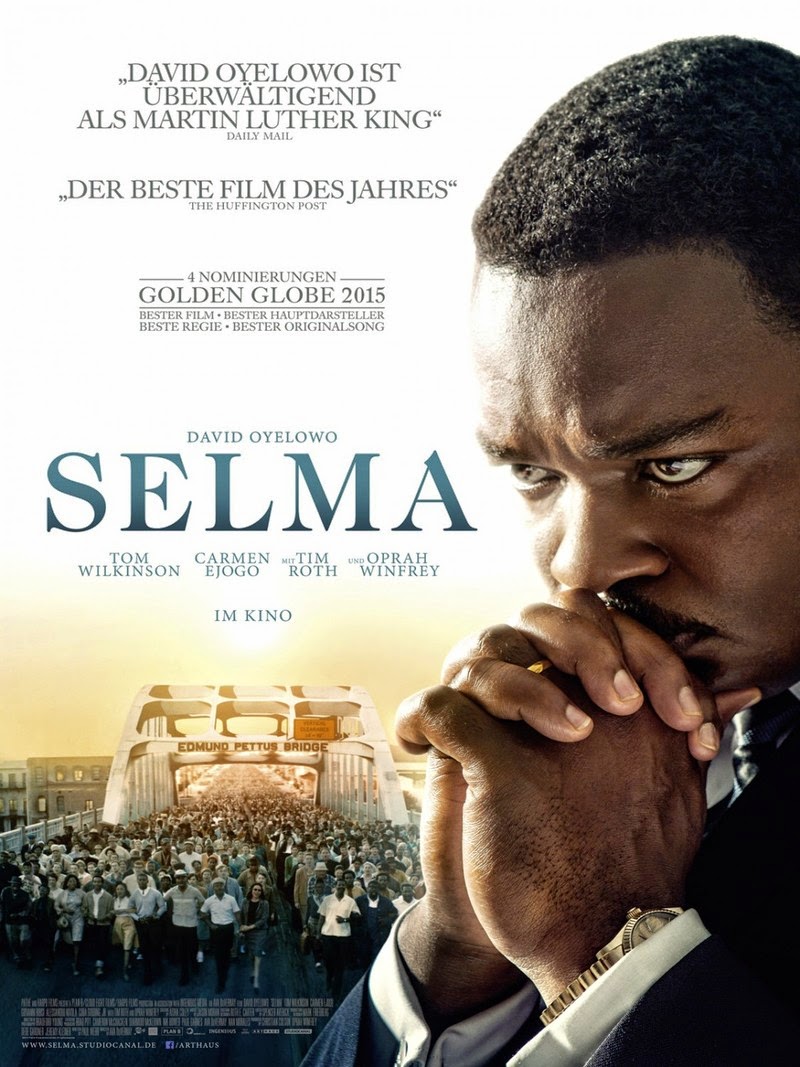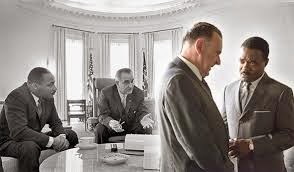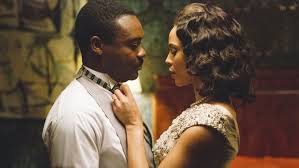 The five most
confusing words in film: 'Based on a true story'. Why do film makers
think they are so essential, what makes them assume it will attract
more viewers? Do people want to have history explained to them, or do
the five words give the story some kind of added value, better than
fiction? I wrote about this phenomenon two years ago, particularly
about Lincoln (link to that essay here), noting the sportswriter Peter King's evaluation of Argo: 'it may be inaccurate, but at least it's educational!' We should be able to understand that movies will take liberties with facts, the question being whether they can stay true to the essence of their story's reality, or whether those liberties propagate distortions that become part of the cinema audience's historical record. Irresistible Targets will be catching up on some of the contenders for this year's Oscars -- and 'based on a true story' is part of each one.
The five most
confusing words in film: 'Based on a true story'. Why do film makers
think they are so essential, what makes them assume it will attract
more viewers? Do people want to have history explained to them, or do
the five words give the story some kind of added value, better than
fiction? I wrote about this phenomenon two years ago, particularly
about Lincoln (link to that essay here), noting the sportswriter Peter King's evaluation of Argo: 'it may be inaccurate, but at least it's educational!' We should be able to understand that movies will take liberties with facts, the question being whether they can stay true to the essence of their story's reality, or whether those liberties propagate distortions that become part of the cinema audience's historical record. Irresistible Targets will be catching up on some of the contenders for this year's Oscars -- and 'based on a true story' is part of each one.
Selma is a fascinating contradiction in those terms, because it has attracted much criticism, some of it justified and some of it not, about the limits of artistic license. Having read much of the criticism before seeing the film, I was surprised by how much I liked it in general, and how much I agreed with many of its basic choices. In telling with great scope and emotion the story of the Bloody Sunday march on the Edmund Pettus Bridge, Selma focuses on Martin Luther King's leadership, and his personal difficulties exacerbated by the FBI's sending his wife Coretta tapes of his adultery. It also concentrates on the movement from the inside, showing the black leadership and their own struggles with tactics both to gain their rights and win over hearts and minds.
The cinematic problem is that Selma has trouble telling both those stories comfortably. I made a point that had Lincoln been called Emancipation, the criticisms it received for not paying more attention to black characters fighting for their rights would have been more justified. The reverse is true here, in a sense: apart from John Lewis' conflict with his fellow members of the Student Non-Violent Coordinating Committe (SNCC, or Snick) who felt usurped by King and his Southern Christian Leadership Conference (SCLC), the group story reduces the SCLC hierarchy to back-up singers. In a sense, the tapes become a bigger story, and Coretta's return to Martin is the dynamic that propels the bigger story: this is not unusual in Hollywood films, but here the personal also has a bigger context. Note the contrast of the two movie posters: the one above right concentrates on King & his internal battle; the one below left shows King facing his external battle. 

In a key moment of the film we see President Lyndon Johnson tell FBI boss J.Edgar Hoover to use the tapes. In fact, there is no evidence LBJ asked for, much less condoned, Hoover's attempt at blackmail. In fact, the FBI sent the tapes to virtually every major southern newspaper; no editor, no matter how virulently segregationist, used them. Today, they'd be on TMZ in an instant, without even having to be leaked to Matt Drudge. The world has not changed for the better in some ways.
More importantly, though, Selma's director (Ava duVernay) and writer (Paul Webb) have decided that King needs a worthy antagonist, and with a crop of juicy villains on offer (Hoover, Alabama governor George Wallace, Dallas county police chief Jim Clark) they wanted that villain to be Johnson. I hold no great affection for LBJ, but casting him as the villain here is unfair and unjustified by the public record. Having passed the Civil Rights Act of 1964, something the Kennedys would never have been able to do, Johnson was wary of trying to cajole Congress a second time on behalf of Voting Rights, that much is true. And he disliked King's moral high ground, in part because, even as a southerner, he knew King was right.
But rather than stand in King's way, Johnson actually had agreed with King that action was necessary, telling him to provide images which would make America rally to the underdog's cause. Far from trying to stop the Selma marchers, LBJ had given them public support on 4 February, three weeks before Jimmy Lee Jackson was shot. He continued to try to minimise the loss of political capital his own confrontation with Wallace would cost, but it was federal judges (Daniel Thomas and Frank Johnson, the latter played by Martin Sheen with echoes of President Barlet) who acted, and Johnson who not only sent troops but took over the Alabama National Guard, to protect the marchers.

DuVernay consciously underplays this. Johnson's March 15th 'We Shall Overcome' speech is one of the great Presidential speeches in American history, and was given to a packed session of both houses of Congress. In the film, there are a few congressmen sitting in an empty auditorium. Johnson knew the import of what he was doing: when he signed the Civil Rights Act, he said 'there goes the South', and so it has happened. The Dixiecrat wing of the Democratic Party had always been an anomaly, but one that kept the Democrats in power. Since 1968, America has listed remarkably back to the right.
Johnson's speech was also carried live by the three television networks. Selma doesn't show this, but the film does show the March 7th march being watched live on television, which did not happen. There was film on the evening newscasts, which we watched, but there was no live broadcasting from the field in 1965.
One of the highlights of the film for me was watching the conversation between Coretta King and Malcolm X, on the same day Johnson first gave his public support. Malcolm positions himself between King and Johnson, much as Johnson himself had, and points the way toward a unified leadership that, had Malcolm not been assassinated weeks later, might have changed the course of the civil rights movement. Watching Nigel Thatch as Malcolm reminded me of just how well the black cast is matched to their characters: not just  David Oyewolo as King or Carmen Ejogo as Coretta, who inhabit those roles (and Oyewolo's in particular is a best-actor worthy performance), but I knew who Andrew Young, or Ralph Abernathy or Bayard Rustin were before the film identified them, a tribute to casting as well as acting. By contrast, Tom Wilkinson all dropped chin and jowls as LBJ, Tim Roth as Wallace and Dylan Baker as Hoover give more stylised performances (Baker's is particularly good in getting Hoover's slimy discomfort with black sexuality--in a sidebar that didn't need to be part of the movie, Viola Liuzzo, the Detroit woman who, as subtitles inform us afterwards, was murdered while driving marchers, was accused falsely by the FBI of being a Communist Party member and having abandoned her children to seek sex from black men: these were Hoover's strongest weapons).
David Oyewolo as King or Carmen Ejogo as Coretta, who inhabit those roles (and Oyewolo's in particular is a best-actor worthy performance), but I knew who Andrew Young, or Ralph Abernathy or Bayard Rustin were before the film identified them, a tribute to casting as well as acting. By contrast, Tom Wilkinson all dropped chin and jowls as LBJ, Tim Roth as Wallace and Dylan Baker as Hoover give more stylised performances (Baker's is particularly good in getting Hoover's slimy discomfort with black sexuality--in a sidebar that didn't need to be part of the movie, Viola Liuzzo, the Detroit woman who, as subtitles inform us afterwards, was murdered while driving marchers, was accused falsely by the FBI of being a Communist Party member and having abandoned her children to seek sex from black men: these were Hoover's strongest weapons).
The film follows our present-day iconography by downplaying the importance of religion to King and the movement. I recall him as Reverend King, and it was partly from this status as a churchman that he gained much of his support outside the South. The film also somewhat downplays the ecumenical nature of the third march; those remarkable photos of white nuns arm in arm with local blacks still resonate. Growing up with a (Congregational) minister who was taking time off to work in the Civil Rights movement in the south, I knew first-hand of the religious foundation of the movement. We see James Reeb, the Unitarian minister from Boston, get murdered, and we see Greek Orthodox Archibishop Lakovos, also from Massachusetts, standing with King. But we don't necessarily realise how many of the SCLC hierarchy were ministers themselves, nor do we see the bearded figure of Rabbi Abraham Herschel marching in the front row with King. The small point of the once-strong bond between blacks and Jews in liberal causes, which has now largely disappeared, was worth a small nod. In fairness, the film does place a less-conspicuous rabbi up front next to Lakovos.
 David Oyewolo as King or Carmen Ejogo as Coretta, who inhabit those roles (and Oyewolo's in particular is a best-actor worthy performance), but I knew who Andrew Young, or Ralph Abernathy or Bayard Rustin were before the film identified them, a tribute to casting as well as acting. By contrast, Tom Wilkinson all dropped chin and jowls as LBJ, Tim Roth as Wallace and Dylan Baker as Hoover give more stylised performances (Baker's is particularly good in getting Hoover's slimy discomfort with black sexuality--in a sidebar that didn't need to be part of the movie, Viola Liuzzo, the Detroit woman who, as subtitles inform us afterwards, was murdered while driving marchers, was accused falsely by the FBI of being a Communist Party member and having abandoned her children to seek sex from black men: these were Hoover's strongest weapons).
David Oyewolo as King or Carmen Ejogo as Coretta, who inhabit those roles (and Oyewolo's in particular is a best-actor worthy performance), but I knew who Andrew Young, or Ralph Abernathy or Bayard Rustin were before the film identified them, a tribute to casting as well as acting. By contrast, Tom Wilkinson all dropped chin and jowls as LBJ, Tim Roth as Wallace and Dylan Baker as Hoover give more stylised performances (Baker's is particularly good in getting Hoover's slimy discomfort with black sexuality--in a sidebar that didn't need to be part of the movie, Viola Liuzzo, the Detroit woman who, as subtitles inform us afterwards, was murdered while driving marchers, was accused falsely by the FBI of being a Communist Party member and having abandoned her children to seek sex from black men: these were Hoover's strongest weapons).The film follows our present-day iconography by downplaying the importance of religion to King and the movement. I recall him as Reverend King, and it was partly from this status as a churchman that he gained much of his support outside the South. The film also somewhat downplays the ecumenical nature of the third march; those remarkable photos of white nuns arm in arm with local blacks still resonate. Growing up with a (Congregational) minister who was taking time off to work in the Civil Rights movement in the south, I knew first-hand of the religious foundation of the movement. We see James Reeb, the Unitarian minister from Boston, get murdered, and we see Greek Orthodox Archibishop Lakovos, also from Massachusetts, standing with King. But we don't necessarily realise how many of the SCLC hierarchy were ministers themselves, nor do we see the bearded figure of Rabbi Abraham Herschel marching in the front row with King. The small point of the once-strong bond between blacks and Jews in liberal causes, which has now largely disappeared, was worth a small nod. In fairness, the film does place a less-conspicuous rabbi up front next to Lakovos.
 As I said, there is much to admire about Selma, not least its focus on the politics of King and the movement, from the inside. But in the end, that conceit about the live TV broadcast of Bloody Sunday rebounds just a little on the film makers. Because the existing footage, the black and white newsfilm, some of it retained on kinescope, carries more power than the battle scenes on the bridge, which are portrayed well, and make a powerful emotional impact. I recall after the Atlanta Olympics, going to the MLK National Historical Centre in Atlanta, a site given almost no promotion by Atlanta's Olympic committee, and if the locals were correct, getting precious few tourists as a result. But walking around the exhibits, I found myself frozen in front of the news footage from that day, and found tears welling up as I remembered watching it as a kid, reading the articles in Life magazine, and realising again what my country was like when I was growing up with 'truth justice and the American way'. How many sacrifices were made, simply to get us to that imperfect place where we are now. Selma does bring that home. But torn between King's personal struggle and the movement's, it takes an easy way out by making Johnson its villain, and it never really harnesses the power of that fuzzy black and white film. And I say black and white, rather than monochrome, deliberately.
As I said, there is much to admire about Selma, not least its focus on the politics of King and the movement, from the inside. But in the end, that conceit about the live TV broadcast of Bloody Sunday rebounds just a little on the film makers. Because the existing footage, the black and white newsfilm, some of it retained on kinescope, carries more power than the battle scenes on the bridge, which are portrayed well, and make a powerful emotional impact. I recall after the Atlanta Olympics, going to the MLK National Historical Centre in Atlanta, a site given almost no promotion by Atlanta's Olympic committee, and if the locals were correct, getting precious few tourists as a result. But walking around the exhibits, I found myself frozen in front of the news footage from that day, and found tears welling up as I remembered watching it as a kid, reading the articles in Life magazine, and realising again what my country was like when I was growing up with 'truth justice and the American way'. How many sacrifices were made, simply to get us to that imperfect place where we are now. Selma does bring that home. But torn between King's personal struggle and the movement's, it takes an easy way out by making Johnson its villain, and it never really harnesses the power of that fuzzy black and white film. And I say black and white, rather than monochrome, deliberately. 
No comments :
Post a Comment